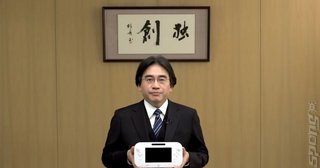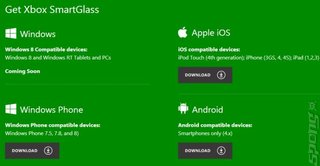Home console launches are typically few and far between. They also typically follow the same well established blueprint that has been with us since the Atari 2600.
Indeed from the 1970s until the launch of the Wii in 2006, each new console was essentially nothing more than a faster version of the last, with better graphics. Sure we went from carts to discs, from predominantly 2D to predominantly 3D, but otherwise, very little changed in the basic model.
Until the launch of the Wii in 2006 that is, when Nintendo changed everything with an exciting and innovative disruptive technology. Wii provoked a response from both Sony (Move) and Microsoft (Kinect). However, while Nintendo was setting the gaming agenda, it was also falling behind in terms of pure pixel pushing power.
Although this was not that important in 2006, when HDTVs were expensive and uncommon, by the start of this decade, with flatscreen the rule, not the exception - it was hurting Nintendo's sales.
For a while, there was talk of a Wii HD, which would have looked like a tame and defensive move, merely making the Wii the equivalent of a PS3 with Move. Instead, Nintendo has sought to implement another disruptive technology, but this time, the concept and realisation are both a lot more nuanced than the simple, "swing the controller and your cricket club swings too" premise of the Wii.
Wii U combines mobile gaming, tablet computing, motion control and console gaming into one cohesive whole. It's a tall order not just from the point of view of the realisation, but from the point of view of getting the public to "get it".
Initial sales in the US, where the Wii U went on sale ahead of the European launch, indicate that, regardless of whether the public "gets it" or not, they want to get it. Sales of 400,000 in the first week are effectively a sell-put of all units at retail. So demand is high.
Nintendo faces two challenges, though. One is maintaining that demand after the artificially inflated "Holidays" market subsides, and the second is escaping†the casual gaming ghetto that it finds itself in.
Casual gaming is a double edged sword, on the one hand, there are many times more aunties and girlfriends than there are core gamers. But on the flipside once they have Wii Fit and Dance Party Bonanza, they are happy. OK, they may upgrade to Gillian Michael's latest fat-busting game after a year or so, but they don't rush out week after week to scour the shelves for the latest titles.
And yet it is to this casual gaming market that the Wii sold in droves. And also to younger gamers, at whom Nintendo's first-party titles are targeted. Sure there are a number of Nintendo die-hards, who gotta play them all where Mario or Zelda titles are concerned. But not enough of these to make a console a core gaming success story.
Nintendo, with the help of its third-party partners, looks serious about addressing the Core audience with Wii U. Launch title ZombiU has our own 360-owning Dan itching to buy a Wii U. Read more about that here.
It has been observed that the combination of a PSVita and PS3 can do much of what the Wii U can do, and this may be true. But then a PS3 and Move can do anything a Wii can do, and much better - but that didn't make the Move a success. The simple fact is, software developers will not support optional accessories - because they cannot count on any given user having the required hardware.
They may put in little flourishes that optionally use the accessory, but they are often reluctant to aim a game squarely at the optional hardware. This is why the Wii U can do, and will be used for, things that the PS3/Vita combination never will. Developers know that anyone with a Wii U has the GamePad, and vice-versa.
But what about Nintendo's other competitor in the three-horse-race that is the current home console market? Microsoft has chosen to go a third route, between Sony's pairing of two separate pieces of hardware, and Nintendo's bundling of two into one package. Microsoft's SmartGlass application can run on almost any smartphone or tablet, and offers similar features to the Wii U. And this brilliant strategy may well be Wii U's undoing.
While we're really warming to the Tablet/Console combination, we also really like the idea of getting it "for free" by downloading an app, rather than going out and paying £250 for a console that, from a pure graphical power perspective is no better than the PS3 or XBox 360.
There's no denying that Nintendo has something very interesting on its hands. And with the exception of a small showing in Forza Horizon and Halo 4, SmartGlass has had very little impact to date. Wii U is a logical upgrade path for Wii users - they get access to some great new features, and Nintendo's rock solid stable of first party titles.
But, despite Nintendo's best efforts, if Microsoft moves SmartGlass forward, and captures third-party developers it's hard to see many Xbox 360 owners jumping ship.
Indeed from the 1970s until the launch of the Wii in 2006, each new console was essentially nothing more than a faster version of the last, with better graphics. Sure we went from carts to discs, from predominantly 2D to predominantly 3D, but otherwise, very little changed in the basic model.
Until the launch of the Wii in 2006 that is, when Nintendo changed everything with an exciting and innovative disruptive technology. Wii provoked a response from both Sony (Move) and Microsoft (Kinect). However, while Nintendo was setting the gaming agenda, it was also falling behind in terms of pure pixel pushing power.
Although this was not that important in 2006, when HDTVs were expensive and uncommon, by the start of this decade, with flatscreen the rule, not the exception - it was hurting Nintendo's sales.
For a while, there was talk of a Wii HD, which would have looked like a tame and defensive move, merely making the Wii the equivalent of a PS3 with Move. Instead, Nintendo has sought to implement another disruptive technology, but this time, the concept and realisation are both a lot more nuanced than the simple, "swing the controller and your cricket club swings too" premise of the Wii.
Wii U combines mobile gaming, tablet computing, motion control and console gaming into one cohesive whole. It's a tall order not just from the point of view of the realisation, but from the point of view of getting the public to "get it".
Initial sales in the US, where the Wii U went on sale ahead of the European launch, indicate that, regardless of whether the public "gets it" or not, they want to get it. Sales of 400,000 in the first week are effectively a sell-put of all units at retail. So demand is high.
Nintendo faces two challenges, though. One is maintaining that demand after the artificially inflated "Holidays" market subsides, and the second is escaping†the casual gaming ghetto that it finds itself in.
Casual gaming is a double edged sword, on the one hand, there are many times more aunties and girlfriends than there are core gamers. But on the flipside once they have Wii Fit and Dance Party Bonanza, they are happy. OK, they may upgrade to Gillian Michael's latest fat-busting game after a year or so, but they don't rush out week after week to scour the shelves for the latest titles.
And yet it is to this casual gaming market that the Wii sold in droves. And also to younger gamers, at whom Nintendo's first-party titles are targeted. Sure there are a number of Nintendo die-hards, who gotta play them all where Mario or Zelda titles are concerned. But not enough of these to make a console a core gaming success story.
Nintendo, with the help of its third-party partners, looks serious about addressing the Core audience with Wii U. Launch title ZombiU has our own 360-owning Dan itching to buy a Wii U. Read more about that here.
It has been observed that the combination of a PSVita and PS3 can do much of what the Wii U can do, and this may be true. But then a PS3 and Move can do anything a Wii can do, and much better - but that didn't make the Move a success. The simple fact is, software developers will not support optional accessories - because they cannot count on any given user having the required hardware.
They may put in little flourishes that optionally use the accessory, but they are often reluctant to aim a game squarely at the optional hardware. This is why the Wii U can do, and will be used for, things that the PS3/Vita combination never will. Developers know that anyone with a Wii U has the GamePad, and vice-versa.
But what about Nintendo's other competitor in the three-horse-race that is the current home console market? Microsoft has chosen to go a third route, between Sony's pairing of two separate pieces of hardware, and Nintendo's bundling of two into one package. Microsoft's SmartGlass application can run on almost any smartphone or tablet, and offers similar features to the Wii U. And this brilliant strategy may well be Wii U's undoing.
While we're really warming to the Tablet/Console combination, we also really like the idea of getting it "for free" by downloading an app, rather than going out and paying £250 for a console that, from a pure graphical power perspective is no better than the PS3 or XBox 360.
There's no denying that Nintendo has something very interesting on its hands. And with the exception of a small showing in Forza Horizon and Halo 4, SmartGlass has had very little impact to date. Wii U is a logical upgrade path for Wii users - they get access to some great new features, and Nintendo's rock solid stable of first party titles.
But, despite Nintendo's best efforts, if Microsoft moves SmartGlass forward, and captures third-party developers it's hard to see many Xbox 360 owners jumping ship.
The opinion expressed in this article is that of the author and does not reflect those of SPOnG.com except when it does.
Want to vent your gaming spleen? Send 900 words max of well thought-out, deeply analysed opinion and we may even run it. Send in 900 words of incisive but mostly brutally angry invective, and we almost certainly will.
Read More Like This
Comments
This isn't an opinion piece with a cogent argument--it's speculative fiction.
calling it speculative fiction is too kind.






